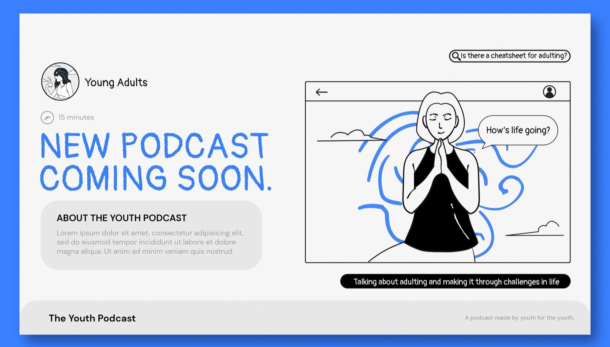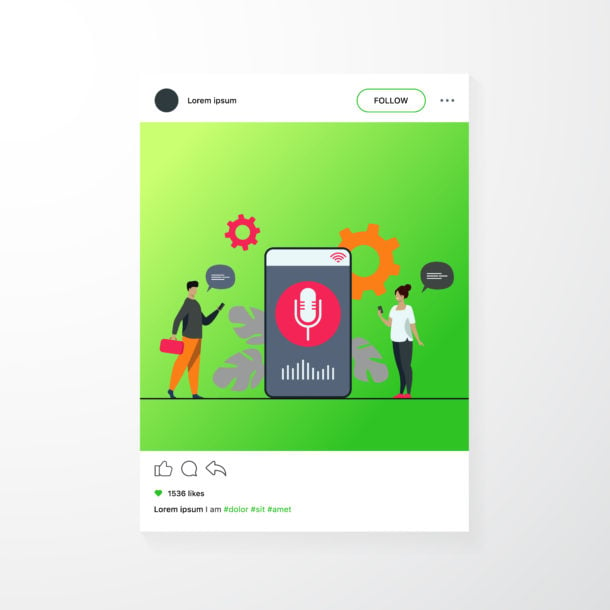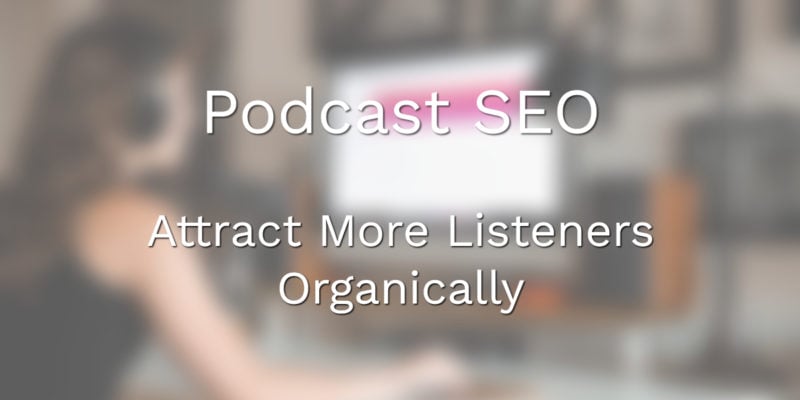A good SEO plan will help more people find your show, attract the right listeners, and grow your audience. It works like a map that leads potential listeners straight to your podcast. SEO doesn’t have to be complicated.
Let’s help your show reach more of the right listeners! That’s why this guide breaks down everything you need to know about making your podcast easier to find online into simple, actionable steps. We know that SEO can feel overwhelming, especially when you’re already putting so much time and effort into crafting great episodes.
Build a Strong Foundation for Your Podcast

Investing in a strong foundation sets your podcast up for long-term success and makes the rest of your SEO efforts far more effective. Before diving into SEO tactics, focus on creating high-quality content and providing an excellent listener experience.
Know Your Target Audience
The better you understand your audience, the more your podcast will feel like it was made just for them. Clearly define your target listener and create content that speaks directly to their interests, challenges, and goals.
Take time to really get to know your audience:
-
Observe the online communities where they spend time. What questions do they ask? What kind of content do they share?
-
Set up interviews with people in your target market. Ask about their challenges, goals, and what they look for in a podcast.
-
Create a listener persona. Give them a name, describe their day, and imagine how your podcast fits into their life.
Focus on Quality
Prioritize creating the best episodes you possibly can before anything else. Let’s be honest – no amount of SEO can make up for a lackluster podcast.
To create valuable, engaging episodes:
-
Have a clear purpose for each episode. What do you want the listener to take away?
-
Follow a logical structure. Use an outline to stay on track.
-
Edit ruthlessly. Remove tangents and fluff. Keep the pacing dynamic.
-
Infuse stories and examples. They’re more compelling than pure information sharing.
-
Prepare thoroughly for interviews so the conversation flows.
-
Include calls-to-action. What do you want the listener to do next?
Audio quality matters. Listeners will tune out if they can’t hear you clearly or the sound is grating. Thankfully, a few simple steps can drastically improve your audio:
-
Record in a quiet room with soft furnishings to reduce echo.
-
Use a microphone with a pop filter to minimize distracting sounds.
-
Keep your mic at a consistent distance from your mouth.
-
Use editing software to reduce background noise and adjust levels.
Pick the Right Hosting Platform
Choosing a podcast host that can support your show’s current needs and future growth is a decision you want to get right from the start. Your hosting platform impacts everything from your show’s reach to your workflow to your listener experience.
Look for a podcast host that provides:
-
Ample storage and bandwidth that grows with your show
-
Detailed analytics on your listeners and episode performance
-
An optimized, mobile-friendly website for your show
-
Tools to streamline publishing and distribution
-
Marketing features like dynamic ads and promotional links
-
Excellent customer support, including migration help if needed
Consider both your current needs and your future goals. Some reputable, growth-oriented podcast hosts to consider:
-
Buzzsprout
-
Transistor
-
Simplecast
-
Captivate
While you can switch later, it’s a hassle you’ll be glad to avoid. Take advantage of free trials to test out different options. Be sure to read reviews from real podcasters, not just the company’s marketing copy.
Find the Right Keywords to Attract Your Listeners

Keyword research lets you discover exactly what your audience is searching for. With over 2 million podcasts out there, you can’t just wait for your ideal listeners to stumble upon your show.
Start with Seed Keywords
Identifying your “seed keywords” is the first step. If you tell a stranger about your show, the words you use are likely seed keywords. These are the most important words and phrases related to your podcast’s core focus.
For example, if you have a podcast about vegan cooking, your seed keywords might be:
-
Vegan recipes
-
Plant-based cooking
-
Meatless meals
-
Dairy-free desserts
You’ll combine these seed keywords with other terms to create longer, more specific “long-tail keywords” in the next step. But brainstorming this initial list gives you a solid starting point.
Use Keyword Research Tools
Expand your seed keyword list into a more robust set of long-tail keywords using tools that provide real data on the search terms your potential listeners are using:
-
Google Keyword Planner: Free with a Google Ads account. Provides search volume and competition data.
-
Answer the Public: Free tool that generates questions and phrases people are searching for related to a topic.
-
Moz Keyword Explorer: Paid tool with a free trial. Offers keyword suggestions, search volume, difficulty scores and SERP analysis.
-
SEMRush: Paid tool with a free trial. Extensive keyword data plus competitor research features.
Look for keywords that have a good balance of search volume (meaning people are searching for them) and lower competition (meaning not many other podcasts are targeting them). This is where you may find opportunities to rank more easily.
Keep in mind that the goal isn’t to stuff as many keywords as possible into your show. Focus on a small, relevant set of keywords for each episode. It’s to understand how your audience thinks and searches, so you can create content that connects with them naturally.
Learn from Other Podcasts
Analyzing the keywords other successful podcasts in your niche are ranking for can provide valuable direction. There’s no need to reinvent the wheel.
Use SEO tools like Moz or SEMRush to research the top podcasts in your category. Take special note of their most popular episodes and what topics they cover. Plug their website into the tool to see what keywords they show up for.
You can also use this intel to find gaps. Standing out is just as important as fitting in. What questions or angles are your competitors not covering? How can you put your unique spin on a high-performing topic?
Additional strategies for staying on top of trending topics in your niche:
-
Set up Google Alerts for important keywords. You’ll get an email digest of new relevant content.
-
Follow thought leaders and influencers in your industry on social media. See what they’re talking about.
-
Read industry blogs, magazines and journals. Look for patterns and recurring themes.
The most effective keyword strategy combines data with your own subject matter expertise. Use these tools and techniques as a starting point, then filter everything through your unique point of view.
Use Keywords Strategically Throughout Your Podcast

You need to incorporate your target keywords intentionally across your show’s touchpoints for them to boost your search rankings. But this doesn’t mean awkwardly cramming them in everywhere. The key is natural, value-adding placement.
Craft Descriptive, Keyword-Rich Episode Titles
Your episode titles are the first thing potential listeners see in search results and podcast apps. They have a big influence on whether someone decides to tune in.
The first title tells you almost nothing about what’s inside. But the second is packed with compelling, keyword-focused information. You instantly know the episode will teach you a specific cooking technique, feature an expert guest, and likely include a recipe.
Some tips for writing strong, SEO-friendly episode titles:
-
Include numbers: “5 Tips for Going Vegan on a Budget”
-
Make a promise: “The Foolproof Method for Perfectly Roasted Vegetables”
-
Evoke curiosity: “Why You’ve Been Cooking Tofu All Wrong”
-
Mention guests’ credentials: “Dr. Jane Smith Shares Her Plant-Based Nutrition Secrets”
-
Target specific searches: “The Ultimate Vegan Thanksgiving Menu”
Keep a running list of title ideas as you batch-produce episodes. Aim for a mix of more competitive “big ticket” keywords and less competitive long-tail phrases. Try plugging potential titles into keyword tools to see how they perform.
Most importantly, make sure your title is an accurate, compelling reflection of what’s inside the episode. It should be intriguing enough to earn a click and honest enough to deliver on its promise.
Write Robust, Engaging Show Notes
Show notes are the written companion to each episode that appear on your website and in podcast directories. They give potential listeners a preview of what’s inside the episode, allow you to share links and resources, and help search engines understand and index your content.
How you structure and format your show notes has a big impact on their SEO value. Here’s a template to follow:
-
Start with a brief, keyword-optimized summary of the episode’s main themes and takeaways.
-
Use header tags (H1, H2, H3) to break the content into skimmable sections.
-
List the key topics covered as bullet points under each header.
-
Include direct quotes from the episode in blockquote or pull quote formatting.
-
Embed a media player so people can listen directly from your show notes.
-
Add timestamps to key sections so listeners can jump to the parts they’re most interested in.
-
Include a full transcript of the episode. This is great for accessibility and gives search engines more content to crawl.
-
Add images with descriptive alt text. This could be episode artwork, guest photos, or infographics.
-
Place links strategically throughout the show notes, including back to your own site and to high-quality external resources.
Aim to write at least 300 words of show notes for each episode. Focus on quality over quantity and always write for humans first, search engines second. This gives search engines enough content to work with without being overwhelming.
Create a Search-Friendly Website for Your Podcast

An optimized website helps you put your best foot forward and earn more organic search traffic if someone Googles your podcast. Even if most people listen within podcast apps, having a designated home base for your show online is a key piece of your SEO strategy.
Choose a Relevant, Memorable Domain Name
Your domain name is your site’s permanent address on the web. Aim for something clear, concise, and easy to spell. Ideally, it’s the name of your podcast.
If your exact show name isn’t available, you can get creative by adding words like:
-
FM
-
Radio
-
Show
-
Podcast
You can check domain availability and purchase your domain through sites like Google Domains, GoDaddy or Namecheap. Expect to spend around $10-15 per year.
Build Your Site with SEO in Mind
With your domain purchased, you’re ready to build your actual website. The easiest way to get up and running is to use a website builder like:
-
Squarespace
-
Wix
-
WordPress
Most of these offer pre-designed templates specifically for podcasts. Look for features like built-in media players, subscribe buttons and show note publishing.
As you customize your site, prioritize:
-
Mobile-friendliness: Choose a responsive design template that automatically adjusts to different screen sizes. Google prefers mobile-optimized sites.
-
Fast loading speed: Compress images and limit the use of large media files and external scripts. Visitors (and search engines) will bounce if pages are slow to load. Use Google’s PageSpeed Insights tool to diagnose issues.
-
Clean organization and navigation: Create a logical page hierarchy with clear menus. Every page should be accessible in 3 clicks or less. Key pages to include:
-
Home
-
About
-
Episodes
-
Contact
-
Subscribe
-
-
Keyword optimization: Incorporate your target keywords naturally throughout your site copy. This includes:
-
Page titles and meta descriptions
-
Header tags
-
Image alt text
-
Page URLs
-
Body copy
-
-
Internal linking: Whenever you mention a topic you’ve covered in a past episode, link to that episode’s show notes page. This helps establish topical authority.
-
Detailed “Subscribe” page: Create a dedicated page with buttons linking to your show on all the major podcast platforms and detailed instructions on how to subscribe. Make it as easy as possible for new listeners to tune in.
-
Strong calls-to-action: Place prominent “Subscribe” and “Leave a Review” buttons in your site header and footer. Offer a lead magnet like a free ebook or worksheet in exchange for joining your email list.
Your website is an extension of your show’s brand and voice. Update it regularly as you publish new episodes. Treat it with the same care and attention you bring to your episodes.
Promote Your Podcast and Build Engagement

Promoting your podcast is the final piece of the SEO puzzle. Even the best shows need to be amplified to cut through the noise and find their audience. You can optimize your show’s on-page elements to perfection, but if no one knows your podcast exists, you won’t gain much traction.
Use Social Media Strategically
Social media can be a powerful tool for expanding your podcast’s reach and deepening your relationship with listeners. But it demands intention, consistency and a willingness to engage.
Some tips for using social media effectively:
-
Choose 1-2 platforms to focus on based on where your target audience spends their time. Quality beats quantity.
-
Develop a clear brand voice and aesthetic. Keep it consistent across all posts.
-
Create audiograms featuring short clips from your episodes. Tools like Headliner and Wavve make this easy.
-
Design quote graphics using excerpts from each episode.
-
Post video trailers or behind-the-scenes content on YouTube.
-
Ask listeners questions and run polls. Not every post should be purely promotional.
-
Respond promptly to comments and messages. Make your audience feel heard.
-
Analyze your post performance and double down on the types of content that resonate best.
It’s important to remember that social media platforms are designed to promote content that is engaging. The more likes, shares, and saves your posts earn, the more people will see them. Focus on sharing valuable, relevant content that sparks conversation.
Collaborate with Other Podcasters
One of the most effective ways to grow your podcast audience is to tap into other podcasters’ existing audiences. This is where guest appearances and cross-promotion come in.
Reach out to podcasts that share a similar target audience but aren’t direct competitors. Offer to swap guest spots, promote each other’s shows, or even co-create bonus content together.
Some specific collaboration ideas:
-
Pitching yourself as a guest expert on a relevant topic
-
Inviting another host to share their unique perspective with your audience
-
Doing a “trailer swap” where you each play a promo for the other’s show
-
Creating a joint resource guide or workbook based on a shared theme
-
Hosting a live Q&A or webinar together
-
Running a joint giveaway or contest
The key is to make it a true value exchange. Don’t just pitch; think about what you can offer to enhance their show and serve their listeners.
As you plan your outreach, be sure to:
-
Do your research. Listen to a few episodes to get a feel for the host’s style and audience.
-
Create a personalized pitch. Explain why you’re a good fit and what unique value you’d bring to their listeners.
-
Clarify what you’re asking for. Is it a full guest spot? A quick promo mention? Something else?
-
Make it easy for them to say yes. Suggest specific topics and angles. Offer to provide sample interview questions.
-
Follow up. Podcast hosts are busy. A gentle nudge can help you stay top of mind.
Ultimately, the goal is to build genuine relationships. Focus on providing value, not just self-promotion. A rising tide lifts all boats.
Encourage Listener Reviews and Engagement
Positive reviews make your show more likely to be recommended to new listeners. Ratings and reviews are important trust signals, both to potential listeners and to podcast platforms’ ranking algorithms.
Most listeners won’t think to leave a review unless you ask them to. It’s up to you to make the request – and make it easy for them to follow through.
Some ideas for encouraging reviews:
-
Set up a dedicated “Leave a Review” page on your website with direct links to review your show on Apple Podcasts, Spotify and other key platforms.
-
Mention the importance of reviews in your show intro and outro. Provide a clear call-to-action: “If you enjoyed this episode, please leave us a rating and review on Apple Podcasts.”
-
Incentivize reviews with a giveaway. Enter everyone who leaves a review in a given month into a drawing for a prize pack.
-
Shout out specific reviews on air. Read them verbatim and thank the reviewer by name.
In addition to reviews, prioritize engagement more broadly. The more listeners interact with you and each other, the more invested they become in your show’s success.
Some engagement strategies to try:
-
Deliver bonus content via an email newsletter. This could include behind-the-scenes footage, exclusive interviews or additional resources.
-
Create a Facebook group or Reddit community for your show. Foster discussions around recent episodes and relevant industry news.
-
Run listener surveys to collect demographic data and content ideas. Make it clear you value their feedback.
-
Host live events like virtual meetups, Q&As or workshops.
-
Respond promptly to listener emails and DMs. Make your audience feel seen and appreciated.
Your audience is your most valuable resource. Cultivate those relationships and seek opportunities to offer more than just the basic episodes. An engaged, loyal audience is the best growth engine.
Track Your Podcast Performance and Adjust Your Strategy

Tracking and measuring your results is key to podcast growth, as with any aspect of marketing. But it can be tricky to know which metrics to focus on and what to do with the data once you have it.
Key Podcast Metrics to Track
At minimum, keep an eye on these core performance indicators:
-
Downloads per episode: This is the closest proxy for your overall audience size. Pay attention to trends over time and how different episodes perform relative to each other.
-
Unique downloads: This shows you how many unique devices have downloaded your episodes. It helps you understand your true reach, as opposed to just total plays.
-
Audience demographics: Most podcast hosts provide data on your listeners’ geography, age, gender and listening habits. Use this to better understand and serve your core audience.
-
Listen-through rate: This is the percentage of listeners who complete a given episode. A high listen-through rate indicates your content is engaging and delivering on its promises.
-
Subscriber growth rate: Track how many new subscribers you gain each month. A healthy podcast should see steady, consistent growth.
-
Reviews and ratings: Monitor your average rating and the sentiment of your reviews. Respond to negative reviews promptly and professionally.
You can access most of this data through your podcast hosting dashboard. For more robust analytics and benchmarking, consider tools like Podtrac or Chartable.
Analyzing and Acting on Your Podcast Data
Data is only useful if you put it to work. Schedule regular time to review your analytics and identify opportunities for improvement.
Some questions to ask as you analyze:
-
Which episodes have the highest download numbers? What themes or formats do they have in common?
-
Are there any episodes with unusually low downloads or listen-through rates? What might have caused listeners to drop off?
-
What are listeners saying in their reviews? Is there a consistent piece of feedback you could address?
-
How does your subscriber growth rate compare to industry benchmarks? Are there any dips or spikes you can’t explain?
Look for patterns and outliers. If a certain topic or guest performs well, consider revisiting it from a new angle. If a heavily promoted episode falls flat, examine where the disconnect occurred.
Some actions you might take based on your analytics:
-
Double down on high-performing topics and episode formats
-
Update your episode titles and descriptions to better reflect what listeners respond to
-
Adjust your publishing schedule to align with when your audience is most likely to tune in
-
Survey listeners to dig deeper into what they like, dislike and want more of
-
A/B test different promotional strategies to see what drives the most subscriptions and reviews
Don’t strive for perfection, instead strive for improvement. Every podcast experiences dips and plateaus. What matters is having a system for consistently monitoring your performance and making data-driven adjustments.
Podcast SEO is a long game. But with a strong foundation, strategic keyword targeting, and a commitment to continuous improvement, you can gradually rise through the ranks and attract your ideal listeners.
Stay focused on creating genuinely valuable content and building authentic connections. With consistent effort and patience, the rest will follow. Your audience is out there, waiting to discover their new favorite show.
